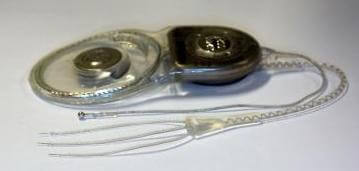
Researchers at the University of Washington are pioneering an area of cybernetics that few have explored: the sense of balance. On October 21st a team at the UW Medical Center, including Jay Rubinstein and James Phillips, successfully installed a cochlear implant in a 56 year old male. Unlike most cochlear implants, this device wasn’t connected to improve the patient’s hearing, but to override misfiring balance signals in his inner ear. The man, who suffers from Meniere’s Disease, experiences periods of debilitating vertigo. Now, when he feels a wave of dizziness begin, he can activate his cybernetic implant and stop the sensation. At least, that’s the hope. This work is part of a 10 person surgical trial that has just begun at UW. In the months ahead, Rubinstein, Phillips and their colleagues hope to explore how these devices may bring a sense of balance to their patient’s lives. Watch the UW team explain Meniere’s and the new use for a cochlear implant in the video below. It’s amazing how much can be done when scientists adapt old technology to new purposes.
While Meniere’s Disease can be associated with tinnitus and hearing loss, the most dramatic impact it typically has is an overwhelming sense of vertigo. Patients may experience such strong dizziness that they have to lay down for hours at a time. Many transition between careers to fit their disability. Changes in diet, medications, and destructive surgeries can treat some of the symptoms of Meniere’s, but few promise a solution that will keep them well-balanced in the long term. While there is some argument about the overall prevalence of Meniere’s in the world, it’s probably around 0.2% in the US. So, there are probably hundreds of thousands of patients in the US, maybe millions around the world, who could benefit from a balance implant for Meniere’s. If the UW technique could be adapted for other balance disorders that number would rise considerably.
Images and discussion of the implant itself start around 1:30.
The cochlear implant treats vertigo by overwhelming the misfiring signals created by Meniere’s disease. When activated by a patient, the device sends electrical signals to the labyrinth of the inner ear where your sense of balance is based. Traditional cochlear implants need several channels because they are trying to replicate sound signals for the audio nerve. The balance implant only needs four leads, making it simple to program and hopefully less prone to failure.
Part of what impresses me about this work is that the doctors at UW Medical Center were wise enough to adapt an existing technology – the cochlear implant – rather than starting from scratch. The device implanted in the recent patient came form Cochlear Ltd. This changed what would probably be a decade long project to an experiment that could be started in a few years. Adapting an FDA approved device also sped up FDA sanction for the balance based cochlear implant trials. If these first 10 cases prove to be safe, and hopefully produce positive results, we could see this new use of cochlear implants hit the market fairly quickly. Hundreds of cyborgs with balance implants could be walking the streets in a few years.
Using cochlear implants to treat balance disorders is a prime example of how cybernetics may expand quickly after initial successes. Once you start reaching inside the body with machines to treat one problem, other opportunities for adjustments will present themselves. Will sight implants be used to treat headaches, or insulin implants help with new forms of hormone therapy? It’s great to remember that the ‘slippery slope’ is sometimes sliding us into new chances to heal that we haven’t considered before. As always, I’m inclined to wonder how long it will take for implants to stop restoring lost senses and start augmenting our natural ones. Sight and hearing are very complex and require many channels of input for a machine to match human capability. Balance might be much simpler. It’s likely decades before we’ll see cyborgs with hawk-like vision or bat-like hearing, but maybe we’ll be able to augment our sense of balance much sooner. Walking to work on a tight rope could be fun.
[image credit: Cochlear Ltd]
[source: UW News]


